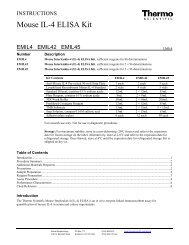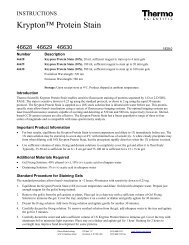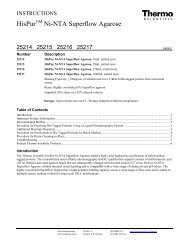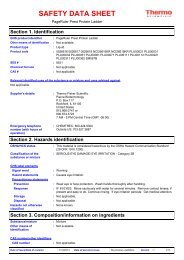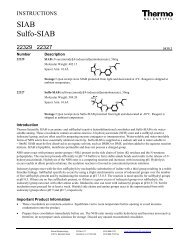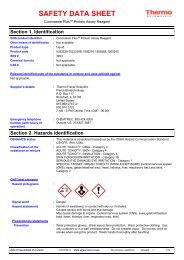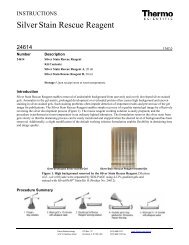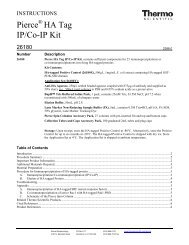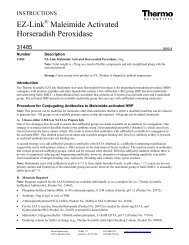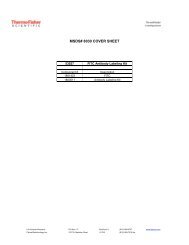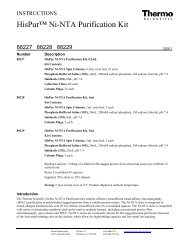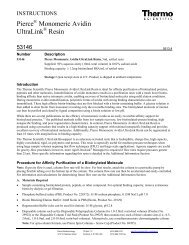Pierce 96-well Microdialysis Plate
Pierce 96-well Microdialysis Plate
Pierce 96-well Microdialysis Plate
You also want an ePaper? Increase the reach of your titles
YUMPU automatically turns print PDFs into web optimized ePapers that Google loves.
Important Product Information<br />
• To prevent contamination, do not touch the membrane with ungloved hands.<br />
• Once wet, do not let the membrane become dry.<br />
• The microdialysis devices can be used individually in 2mL microcentrifuge tubes. (optional)<br />
• If the sample density is ≥ 1.150g/mL, such as protein in saturated 4.1M (NH4)2SO4, 45% sucrose or 8M GuHCl, use<br />
≤ 50% of the maximum sample volume, which allows for the influx of water during dialysis and ensures the device does<br />
not over fill. Performing serial dialysis using buffers with decreasing concentrations of solutes (salt) will prevent the<br />
osmotic pressure from overfilling the device (e.g., dialyze a 5M NaCl sample against a buffer with 0.5M NaCl).<br />
• For high-throughput drug-binding experiments using equilibrium dialysis, we recommend using the Thermo Scientific<br />
RED Device Single-Use <strong>Plate</strong> with Inserts (Product No. 90006).<br />
Additional Materials Required<br />
• <strong>96</strong>-<strong>well</strong> deep-<strong>well</strong> plate, 2.2mL (Product No. 88261)<br />
• Pipette for sample recovery<br />
• <strong>Plate</strong> shaker (optional)<br />
• 2mL microcentrifuge tubes (optional)<br />
Procedure for using the <strong>Pierce</strong> <strong>96</strong>-<strong>well</strong> <strong>Microdialysis</strong> <strong>Plate</strong><br />
1. Remove the required number of microdialysis devices from the plate. Individual devices can be detached from the eightsegment<br />
cartridges. To prevent membrane contamination, handle the device at the top or sides using gloves.<br />
2. Add ≤ 1800µL of dialysis buffer to the appropriate number of <strong>well</strong>s in a <strong>96</strong> deep-<strong>well</strong> plate or ≤ 1400µL of dialysis<br />
buffer to a 2mL microcentrifuge tube and set aside.<br />
3. Add 100µL of dialysis buffer to each microdialysis device by slowly adding the buffer through the round opening of the<br />
device.<br />
4. Remove the buffer from the device by setting the pipette volume to 140µL, inserting the pipette tip into the round<br />
opening and slowly aspirating the buffer. Do not let the membrane become dry.<br />
5. Load the sample (10-100µL) slowly as described in Step 3. Confirm that the sample is settled at the bottom of the device,<br />
especially when loading a small volume (e.g., 10µL), by carefully pushing the sample down with air through the pipette.<br />
6. Place the device into the deep-<strong>well</strong> plate or 2mL microcentrifuge tube containing the buffer (Step 2). Cover the top<br />
(sample loading portion) of the device with laboratory film.<br />
7. Shake the plate gently on a plate shaker (optional).<br />
8. Dialyze for an amount of time sufficient to remove low-molecular weight compounds for the specific downstream<br />
application (1 hour to overnight). A typical dialysis using two buffer changes takes less than 5 hours to remove salts<br />
(e.g., 1M NaCl, Figure 1); however, dialysis time will vary depending on the salt and small molecule concentrations. A<br />
typical dialysis procedure is as follows: dialyze for 2 hours at room temperature or 4ºC; change the dialysis buffer and<br />
dialyze for another 2 hours; if needed, change the dialysis buffer and dialyze overnight. To change the buffer, move the<br />
microdialysis device into a new deep-<strong>well</strong> plate channel or use a new microcentrifuge tube.<br />
9. Remove the device from the plate and recover the sample as described in Step 4.<br />
<strong>Pierce</strong> Biotechnology PO Box 117 (815) <strong>96</strong>8-0747 www.thermoscientific.com/pierce<br />
3747 N. Meridian Road Rockford, lL 61105 USA (815) <strong>96</strong>8-7316 fax<br />
2



